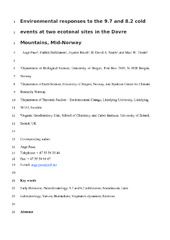Environmental responses to the 9.7 and 8.2 cold events at two ecotonal sites in the Dovre mountains, mid-Norway
Peer reviewed, Journal article
Accepted version
Permanent lenke
https://hdl.handle.net/1956/22716Utgivelsesdato
2019Metadata
Vis full innførselSamlinger
Originalversjon
Quaternary Science Reviews. 2019;205:45-61 https://doi.org/10.1016/j.quascirev.2018.12.009Sammendrag
We found strong signals of two cooling events around 9700 and 8200 cal yrs. BP in lakes Store Finnsjøen and Flåfattjønna at Dovre, mid-Norway. Analyses included pollen in both lakes, and C/N-ratio, biomarkers (e.g. alkanes and br-GDGTs), and XRF scanning in Finnsjøen. The positions of these lakes close to ecotones (upper forest-lines of birch and pine, respectively) reduced their resilience to cold events causing vegetation regression at both sites. The global 8.2 event reflects the collapse of the Laurentide Ice Sheet. The 9.7 event with impact restricted to Scandinavia and traced by pollen at Dovre only, reflects the drainage of the Baltic Ancylus Lake. More detailed analysis in Finnsjøen shows that the events also caused increased allochtonous input (K, Ca), increased sedimentation rate, and decreased sediment density and aquatic production. br-GDGT-based temperatures indicate gradual cooling through the early Holocene. In Finnsjøen, ca. 3100 maxima-minima couplets in sediment density along the analysed sequence of ca. 3100 calibrated years show the presence of varves for the first time in Norway. Impact of the 9.7 and 8.2 events lasted ca. 60 and 370 years, respectively. Pine pollen percentages were halved and re-established in less than 60 years, indicating the reduction of pine pollen production and not vegetative growth during the 9.7 event. The local impact of the 8.2 event sensu lato (ca. 8420–8050 cal yrs. BP) divides the event into a precursor, an erosional phase, and a recovery phase. At the onset of the erosional phase, summer temperatures increased.

